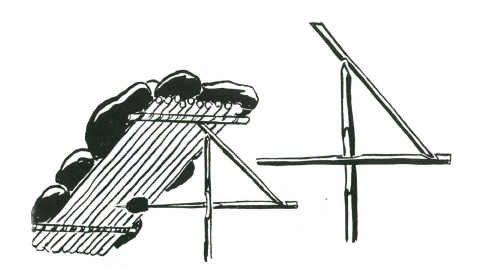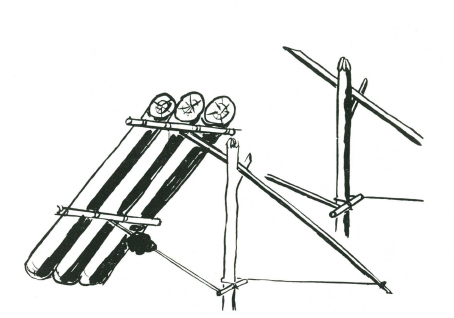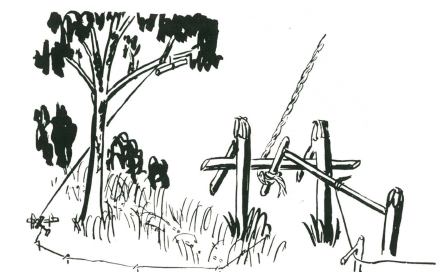NOOSE SNARE STICKS FOR SMALL BIRDS
NOTE.—This is a prohibited snare, illegal in many districts. It should not be used except to catch pests.

A straight stick three to four feet long is selected. Onto this many fine nooses, each between ½” and 1” in size, of horse hair are tied securely and the stick is then tied with the nooses uppermost to a shrub or small tree which is a favourite resting place for small birds. They alight on the stick, and their feet become entangled in the snares. One or two birds so caught will call others to them, and in a short time seven or eight birds will be all snared on the noose stick.
This type of snare stick is condemned for general use. It has a place for the orchardist to clear starling and fruit eaters from his orchard, but it should not be used to snare small birds such as finches and wrens for the purpose of putting them into captivity. If you see such a stick, obviously set for such a purpose, take it and destroy it. You will be doing the birds a good turn by this action.
LOGFALL
SLIP RELEASE OF BAIT STICK

This logfall is suitable for ground living animals, and depends for its action upon the turning or twisting of a forked bait stick, one end of which is sharpened to a point which in turn supports the smoothly cut face of the cross bar on which the logs are lying. Select a site where the animals feed. Cut your bait stick with a widely forked prong. The lower end should be roughly sharpened, and the top end brought to a sharp point. A stout stake is sharpened and bevelled at the head so that it is nearly flat. This stake is driven securely into the ground. The two or three heavy logs for the fall are selected and trimmed so they will lie together on the cross bar. The cross bar is cut with a squared side at one end, and the other end is trimmed off with a smoothly inclined face. The squared side is laid on the top of the bevelled stake. The logs are laid on the cross bar, and the sharpened point of the bait stick is put under the inclined cut on the end of the cross bar at such an angle that it will slip off if the bait stick is twisted. The lower end of the bait stick rests on a chip of bark or a smooth flat stone so that it will not sink into the ground. Sensitivity is adjusted by the angle of the bait stick on the cut at the end of the cross bar.
LOGFALL
SQUARED FACE RELEASE OF BAIT STICK

The general construction of this logfall release is similar to the slip release. A stout stake is sharpened and driven into the ground as for the preceding trap. The cross bar, except for two squared sides in place of the smoothly cut inclined end is exactly the same. The bait stick is forked and at the upper end a square seated cut is made to take the squared side of the cross bar, so that when the weight of the logs is resting on the cross bar the squared side is securely resting on the square cut at the top end of the bait stick. When the prong with the bait is disturbed the bait stick is twisted, and the crossbar unseated so that the logs fall on the animal beneath, either breaking its back instantly or crushing its head so that death is immediate.
LOGFALL
FIGURE FOUR RELEASE

In this type of logfall the two or three heavy logs are bound to cross pieces at head and foot so that they will lie together. Alternatively a platform of light sticks weighted with heavy stones can be made. Release is effected by the Figure 4 method. For this release three strong sticks are selected, one about two feet high for the upright, one about three or four feet long for the bait stick, and one about eighteen inches for the release stick.
The upright is sharpened to a chisel edge at the top, and twelve inches below this and facing the same direction as the straight edge of the chisel end the stick is squared off on two adjacent sides. The bait stick is cut with a nick sloping backwards a couple of inches from the thickest end, and about twelve inches further along with a squared step, the squared side of which is farthest away from the nick. The bait is at the far end of the bait stick. The release stick is sharpened to a chisel edge at either end, and a nick parallel to the chisel edge is cut some few inches from one end. Setting of the trap is effected by standing the upright stick a few inches from the end of the logs. Lifting the logs and putting the release stick under the cross bar, with the chisel cut of the upright in the nick in the release stick. The far end of the release stick is seated in the nick at the end of the bait stick so that it draws the square face of the cut against the squared face of the upright stick. Any disturbance of the bait releases the logfall.
LOGFALL
TOGGLE RELEASE

Two or three logs are secured to a cross bar as for the figure 4 release. The release sticks consist of a forked stick about two feet long for the upright, a support stick about three feet long, a toggle stick of four or five inches, and a bait stick, long enough to reach from the upright stick to the lower cross bar holding the logs together.
The trap is set by standing the upright with the fork uppermost a few inches in front of the logs. The support stick is laid over the fork, and to its farthest end a cord is tied. The length of the cord should reach from the end of the support stick to the upright stick. The end of the cord is fastened to a toggle stick and this is passed around the upright. Against one end of the toggle stick the bait stick is placed so that its farthest end presses against the lowest cross bar. Release is effected when an animal disturbs the bait stick, and so releases the toggle, allowing the logfall to drop.
In place of a group of logs for any of these traps, a platform of stakes, heavily weighted with big stones, may be used with equal efficiency.
LOGFALL
TREE LOGFALL
NOTE—This is an exceedingly dangerous trap. It is so absolutely unsuspected and sudden that it should only be used either to guard against surprise from attack if in a country of hostile natives, or if set to kill large animals. Notices of warning: should be placed at either end of the path. This trap is a man-killer.

A site is selected along a trail which the animals use regularly. The site must have a branch of a large living tree overhanging the path. A heavy line is thrown over the branch so that when allowed to hang free its end will lie on the path. To this line a stout rope is tied and the rope hauled up and over the branch. To one end of the rope a heavy log is slung so that it hangs horizontally.
The log is hoisted to the branch, and the rope brought back so that it is concealed by the tree trunk; a toggle is tied where tire rope touches the ground. At this place two very strong hooked stakes are driven into the ground, and a release similar to any of the noose releases (toggle and bait or reversed toggle) are used to hold the rope.
To what would be the bait stick in the snare release, lengths of cord or ground vine are tied for a trip cord and by means of hooked sticks the trip cord is led through the bush parallel to the animal’s path to positions on either side of the place where the log will drop when it falls. This distance can be calculated by allowing for the log to fall at the rate of 28 feet the first second, 56 the second, and 28 feet more for each further second, and so on. (Drag on the cord reduces the log’s rate of fall to this figure.) If the animal travels at three miles an hour, it moves forward 4 feet 6 inches a second. Thus, if the dog is 100 feet above the path it will take two and a half seconds to fall and the animal will have moved 11 feet 6 inches after it has pulled the trip with its feet.